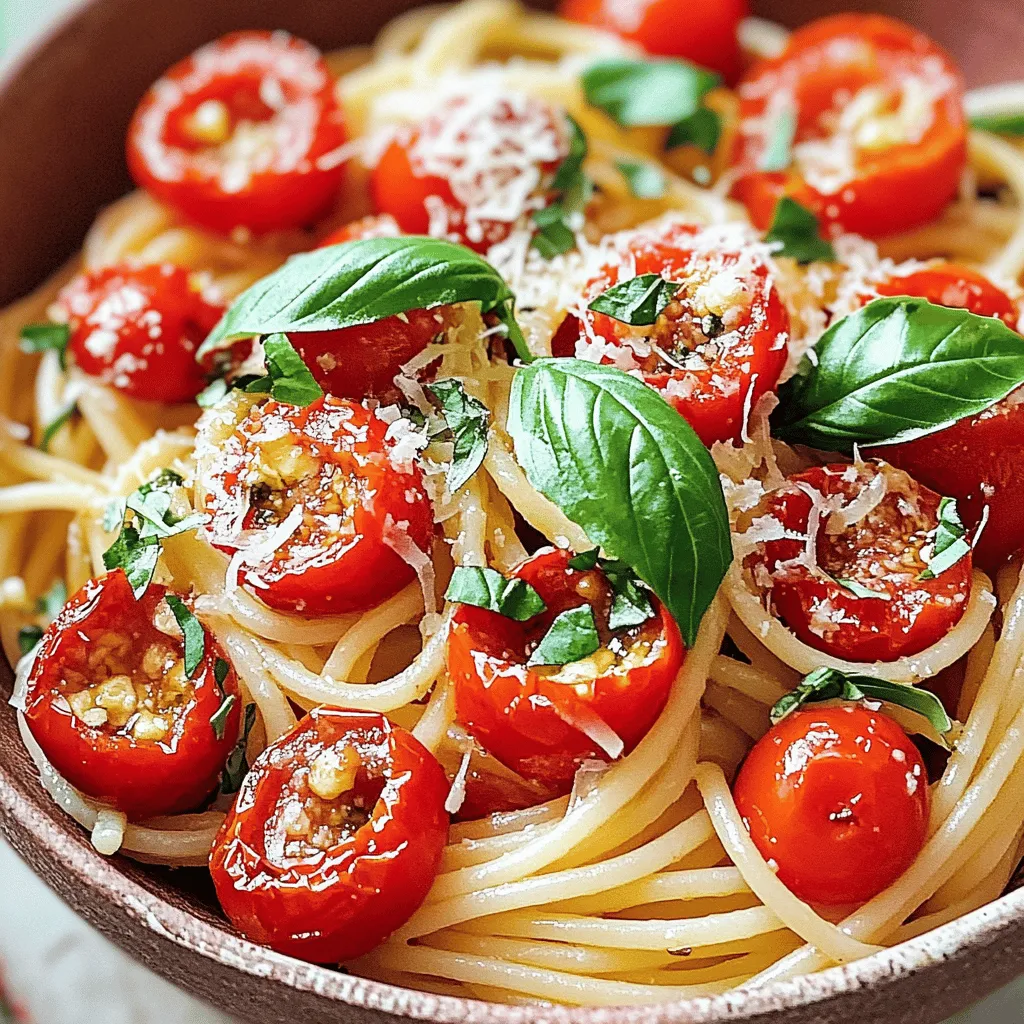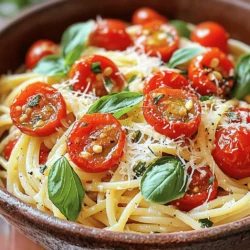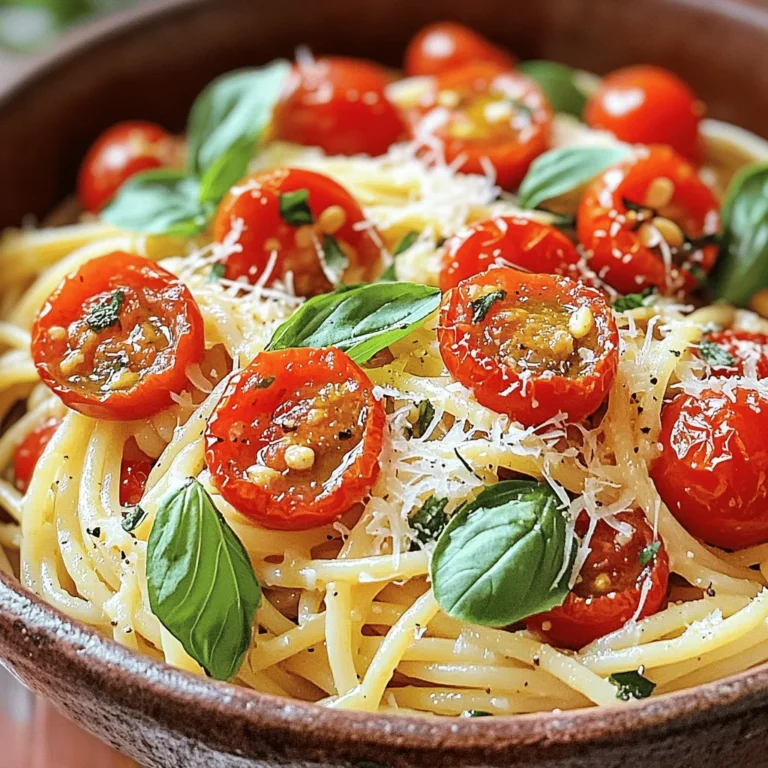Are you ready to take your pasta game to the next level? This Roasted Tomato Pasta recipe is not just delicious; it’s easy to make using simple, fresh ingredients. I’ll guide you through each step, from selecting the best tomatoes to perfectly cooking the pasta. With tips and tricks to enhance flavors, this dish is perfect for any meal. Let’s dive into this flavorful journey together!
Ingredients
List of Ingredients
– 2 cups cherry tomatoes, halved
– 3 tablespoons extra virgin olive oil
– 4 cloves garlic, finely minced
– 1 teaspoon dried oregano
– Salt and freshly cracked black pepper to taste
– 8 oz spaghetti or your preferred pasta
– 1/4 cup fresh basil leaves, roughly chopped
– 1/4 cup grated Parmesan cheese (optional for serving)
– 1 teaspoon balsamic vinegar (optional for depth of flavor)
Each ingredient plays a key role in the dish. The cherry tomatoes bring sweetness and acidity. Olive oil adds richness and helps the flavors meld. Garlic gives a punchy aroma, while oregano adds a hint of earthiness. Salt and pepper enhance all the flavors. Spaghetti provides a perfect base for the sauce. Fresh basil adds brightness and freshness. Parmesan cheese gives a savory finish, if you choose to add it. Balsamic vinegar can deepen the flavor, giving a sweet tang.
Nutritional Information
Each serving has about 350 calories, 10 grams of protein, 60 grams of carbs, and 10 grams of fat. Using fresh ingredients boosts flavor and nutrition. Fresh tomatoes are high in vitamins and antioxidants. Olive oil offers healthy fats that support heart health. Garlic may help boost your immune system. Fresh basil contains vitamins A and K. This dish is not just tasty; it also supports a balanced diet.
Step-by-Step Instructions
Prepping the Ingredients
To start, you need to prepare the cherry tomatoes and garlic. First, wash the cherry tomatoes well. Next, cut each tomato in half. This helps them roast evenly. For the garlic, take four cloves and finely mince them. This step releases their rich flavor.
When selecting tomatoes, look for bright red ones. They should feel firm but not hard. Avoid any tomatoes with blemishes or soft spots. Fresh and ripe tomatoes give the best taste to your pasta.
Roasting the Tomatoes
Roasting the tomatoes is key to this dish. Preheat your oven to 400°F (200°C). This high heat caramelizes the sugars in the tomatoes. On a large baking sheet, combine the halved tomatoes with two tablespoons of olive oil, minced garlic, dried oregano, and some salt and pepper. Toss everything together. Spread the mixture in a single layer to ensure even roasting.
Place the baking sheet in the oven. Roast the tomatoes for about 20-25 minutes. You want them to burst and turn golden around the edges. This brings out their sweet flavor.
Cooking the Pasta
While the tomatoes roast, cook the pasta. Fill a large pot with water and bring it to a rapid boil. Add a generous amount of salt, about one tablespoon, to the water. This helps flavor the pasta. Once boiling, add your spaghetti or preferred pasta. Cook until it is al dente, which means it’s firm to the bite.
After cooking, drain the pasta but remember to reserve about half a cup of the starchy water. This water helps bind the sauce later on.
Combining the Dish
Now it’s time to mix everything together. In a large mixing bowl, combine the roasted tomatoes with any juices from the baking sheet. Add the drained pasta to this mix. Drizzle in the last tablespoon of olive oil and balsamic vinegar if you’re using it.
Toss everything well. Gradually add the reserved pasta water until you reach the right sauce consistency. You want the sauce to coat the pasta nicely, not be too watery. Finally, fold in the chopped basil and taste it. Adjust with more salt and pepper if needed.
Serve your warm pasta in a bowl. You can top it with grated Parmesan cheese if you want. Enjoy this delicious dish!
Tips & Tricks
Cooking Tips
To cook pasta well, avoid common mistakes. First, always use a large pot of water. This gives the pasta space to move around. Add salt to the water; it helps the pasta taste better. Check for doneness by tasting the pasta. It should be firm but not hard. This is called al dente. If you wait too long, it can become mushy.
Flavor Enhancements
Herbs and spices can boost flavor. Try adding fresh basil or parsley. You can also use dried oregano or thyme. These herbs pair well with roasted tomatoes. Balsamic vinegar adds depth to the dish. It has a sweet and tangy flavor. Olive oil makes the pasta rich and smooth. A drizzle of both can elevate your meal.
Presentation Tips
For a great look, serve pasta in a big bowl or on individual plates. Add extra fresh basil leaves on top for color. Grate Parmesan cheese over the dish for a nice finish. Drizzle some olive oil on top for shine. This makes it look gourmet.

Variations
Vegan Roasted Tomato Pasta
To make this dish vegan, swap out the Parmesan cheese for a plant-based alternative. Nutritional yeast is great for a cheesy flavor. You can also use cashew cream for a rich, creamy texture. Add nuts like pine nuts or walnuts for extra crunch. Fresh spinach or arugula can add a peppery taste. Don’t forget to toss in some olives for a briny kick.
Gluten-Free Options
If you need gluten-free pasta, there are many types available. Brown rice pasta or chickpea pasta work well. You can even make your own gluten-free pasta with rice flour and egg or water. There are many recipes online to guide you through this process. Homemade pasta can taste fresher and more delightful.
Regional Variations
Italian cuisine has many styles. In Southern Italy, they often use more garlic and olive oil. Northern regions may add cream for a richer sauce. In Tuscany, roasted tomatoes may mix with capers and olives. Each region has its unique twist on roasted tomato pasta. Explore these variations to find your favorite!
Storage Info
Best Storage Practices
To store leftover roasted tomato pasta, let it cool first. Place the pasta in an airtight container. This keeps it fresh and tasty. You can store it in the fridge for up to three days. For longer storage, freeze it. Use freezer-safe bags or containers to avoid freezer burn.
Reheating Instructions
When reheating, the best method is to use the stove. Place the pasta in a pan over low heat. Add a splash of water or olive oil. This keeps the pasta moist and helps it heat evenly. Stir it gently as it warms up.
If you want to refresh leftovers, consider adding fresh basil or a sprinkle of cheese. This adds flavor and makes the dish feel new again. Enjoy your roasted tomato pasta even after storing it!
FAQs
How long can I store roasted tomato pasta?
You can store roasted tomato pasta in the fridge for about 3 to 5 days. Make sure to use an airtight container to keep it fresh. Before serving, check for any off smells or changes in color. If it looks fine, you can reheat it. Always ensure it reaches 165°F (74°C) when reheating to keep it safe.
Can I freeze roasted tomato pasta?
Yes, you can freeze roasted tomato pasta. Let it cool completely before packing it into freezer-safe containers. Use a container that fits your needs, leaving some space for expansion. When ready to eat, thaw it overnight in the fridge. Reheat it on the stove or in the microwave until hot.
What types of pasta work best with roasted tomato recipes?
Spaghetti is a classic choice, but many types work well. Here are some great options:
– Penne: Holds sauce well.
– Fusilli: Twists catch bits of tomato.
– Farfalle: Fun shape adds variety.
– Whole wheat pasta: Adds nutrition and flavor.
Experiment and find your favorite!
How can I make roasted tomato pasta spicier?
To add some heat, try these simple tips:
– Red pepper flakes: Sprinkle in while mixing the pasta.
– Fresh chili: Chop and sauté with garlic.
– Hot sauce: Drizzle in at serving for extra kick.
Adjust the spice level to your taste!
This blog post covered key ingredients for roasted tomato pasta and their roles. We looked at how to prepare tomatoes and garlic, then roasted them to perfection. We also explored cooking pasta al dente and combining everything for a balanced dish. Let’s not forget the useful tips for flavor and presentation, along with variations for all diets. Fresh ingredients shine in this dish, and you can store leftovers for later. Now, you have all the tools to create a delicious meal. Happy cooking!


